check engine YAMAHA MT-125 2015 Owner's Manual
[x] Cancel search | Manufacturer: YAMAHA, Model Year: 2015, Model line: MT-125, Model: YAMAHA MT-125 2015Pages: 96, PDF Size: 7.28 MB
Page 58 of 96
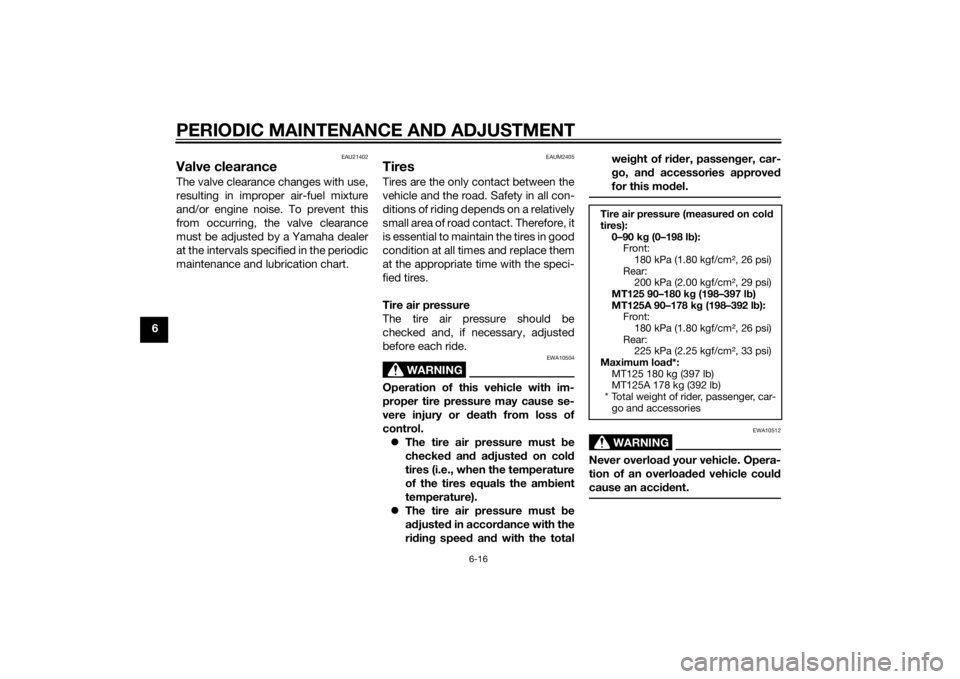
PERIODIC MAINTENANCE AND ADJUSTMENT
6-16
6
EAU21402
Valve clearanceThe valve clearance changes with use,
resulting in improper air-fuel mixture
and/or engine noise. To prevent this
from occurring, the valve clearance
must be adjusted by a Yamaha dealer
at the intervals specified in the periodic
maintenance and lubrication chart.
EAUM2405
TiresTires are the only contact between the
vehicle and the road. Safety in all con-
ditions of riding depends on a relatively
small area of road contact. Therefore, it
is essential to maintain the tires in good
condition at all times and replace them
at the appropriate time with the speci-
fied tires.
Tire air pressure
The tire air pressure should be
checked and, if necessary, adjusted
before each ride.
WARNING
EWA10504
Operation of this vehicle with im-
proper tire pressure may cause se-
vere injury or death from loss of
control.
The tire air pressure must be
checked and adjusted on cold
tires (i.e., when the temperature
of the tires equals the ambient
temperature).
The tire air pressure must be
adjusted in accordance with the
riding speed and with the totalweight of rider, passenger, car-
go, and accessories approved
for this model.
WARNING
EWA10512
Never overload your vehicle. Opera-
tion of an overloaded vehicle could
cause an accident.Tire air pressure (measured on cold
tires):
0–90 kg (0–198 lb):
Front:
180 kPa (1.80 kgf/cm², 26 psi)
Rear:
200 kPa (2.00 kgf/cm², 29 psi)
MT125 90–180 kg (198–397 lb)
MT125A 90–178 kg (198–392 lb):
Front:
180 kPa (1.80 kgf/cm², 26 psi)
Rear:
225 kPa (2.25 kgf/cm², 33 psi)
Maximum load*:
MT125 180 kg (397 lb)
MT125A 178 kg (392 lb)
* Total weight of rider, passenger, car-
go and accessories
U5D7E4E0.book Page 16 Thursday, July 10, 2014 3:01 PM
Page 66 of 96

PERIODIC MAINTENANCE AND ADJUSTMENT
6-24
6
EAU22762
Drive chain slackThe drive chain slack should be
checked before each ride and adjusted
if necessary.
EAUM3550
To check the drive chain slack
1. Place the motorcycle on the side-
stand.TIPWhen checking and adjusting the drive
chain slack, there should be no weight
on the motorcycle.2. Shift the transmission into the
neutral position.
3. Measure the drive chain slack at
the arrow mark on the swingarm
as shown in the illustration.4. If the drive chain slack is incorrect,
adjust it as follows.
EAU34318
To adjust the drive chain slack
Consult a Yamaha dealer before ad-
justing the drive chain slack.
1. Loosen the axle nut and the lock-
nut on each side of the swingarm.2. To tighten the drive chain, turn the
drive chain slack adjusting bolt on
each side of the swingarm in di-
rection (a). To loosen the drive
chain, turn the adjusting bolt on
each side of the swingarm in di-
rection (b), and then push the rear
wheel forward. NOTICE: Improp-
er drive chain slack will over-
load the engine as well as other
vital parts of the motorcycle and
can lead to chain slippage or
breakage. To prevent this from
Drive chain slack:
35.0–45.0 mm (1.38–1.77 in)
1. Drive chain slackZAUM1233
1. Axle nut
2. Drive chain slack adjusting bolt
3. Locknut
4. Alignment marksZAUM1183
U5D7E4E0.book Page 24 Thursday, July 10, 2014 3:01 PM
Page 71 of 96
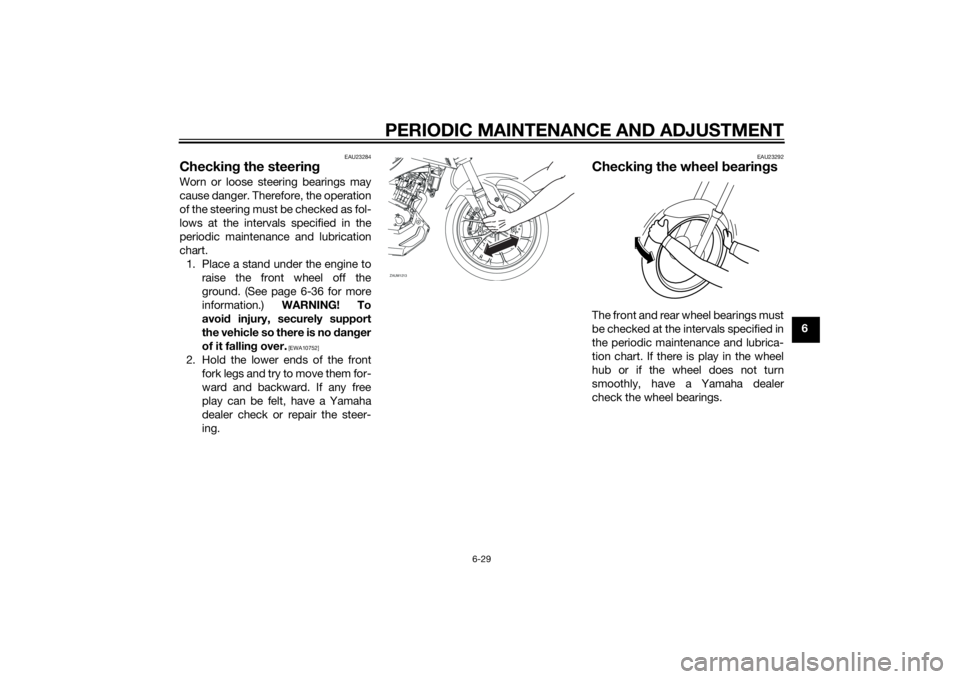
PERIODIC MAINTENANCE AND ADJUSTMENT
6-29
6
EAU23284
Checking the steeringWorn or loose steering bearings may
cause danger. Therefore, the operation
of the steering must be checked as fol-
lows at the intervals specified in the
periodic maintenance and lubrication
chart.
1. Place a stand under the engine to
raise the front wheel off the
ground. (See page 6-36 for more
information.) WARNING! To
avoid injury, securely support
the vehicle so there is no danger
of it falling over.
[EWA10752]
2. Hold the lower ends of the front
fork legs and try to move them for-
ward and backward. If any free
play can be felt, have a Yamaha
dealer check or repair the steer-
ing.
EAU23292
Checking the wheel bearingsThe front and rear wheel bearings must
be checked at the intervals specified in
the periodic maintenance and lubrica-
tion chart. If there is play in the wheel
hub or if the wheel does not turn
smoothly, have a Yamaha dealer
check the wheel bearings.
ZAUM1213
U5D7E4E0.book Page 29 Thursday, July 10, 2014 3:01 PM
Page 78 of 96
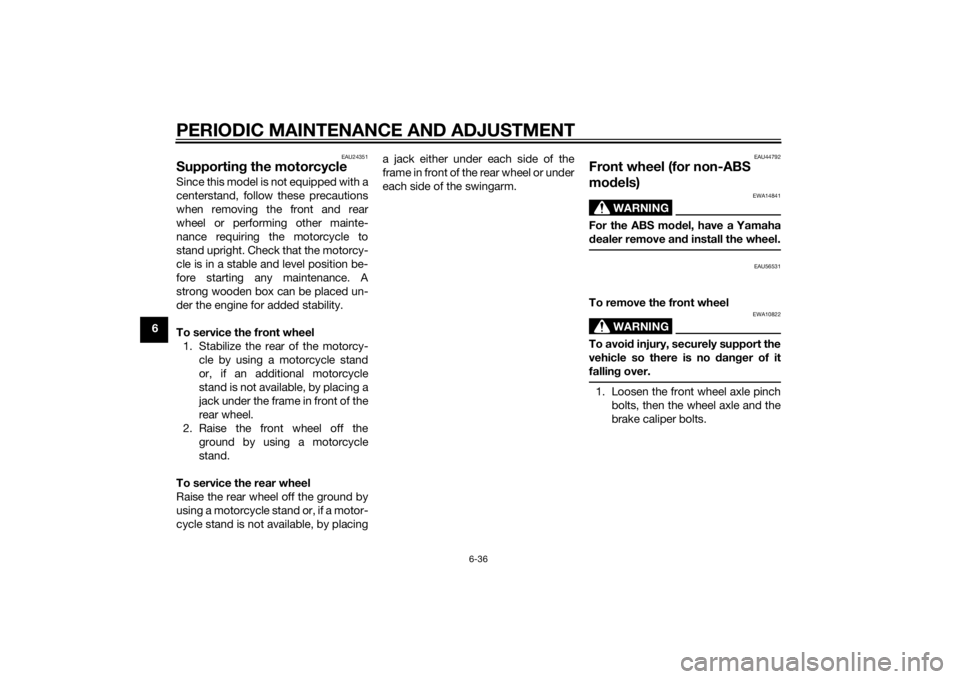
PERIODIC MAINTENANCE AND ADJUSTMENT
6-36
6
EAU24351
Supporting the motorcycleSince this model is not equipped with a
centerstand, follow these precautions
when removing the front and rear
wheel or performing other mainte-
nance requiring the motorcycle to
stand upright. Check that the motorcy-
cle is in a stable and level position be-
fore starting any maintenance. A
strong wooden box can be placed un-
der the engine for added stability.
To service the front wheel
1. Stabilize the rear of the motorcy-
cle by using a motorcycle stand
or, if an additional motorcycle
stand is not available, by placing a
jack under the frame in front of the
rear wheel.
2. Raise the front wheel off the
ground by using a motorcycle
stand.
To service the rear wheel
Raise the rear wheel off the ground by
using a motorcycle stand or, if a motor-
cycle stand is not available, by placinga jack either under each side of the
frame in front of the rear wheel or under
each side of the swingarm.
EAU44792
Front wheel (for non-ABS
models)
WARNING
EWA14841
For the ABS model, have a Yamaha
dealer remove and install the wheel.
EAU56531
To remove the front wheel
WARNING
EWA10822
To avoid injury, securely support the
vehicle so there is no danger of it
falling over.1. Loosen the front wheel axle pinch
bolts, then the wheel axle and the
brake caliper bolts.
U5D7E4E0.book Page 36 Thursday, July 10, 2014 3:01 PM
Page 83 of 96
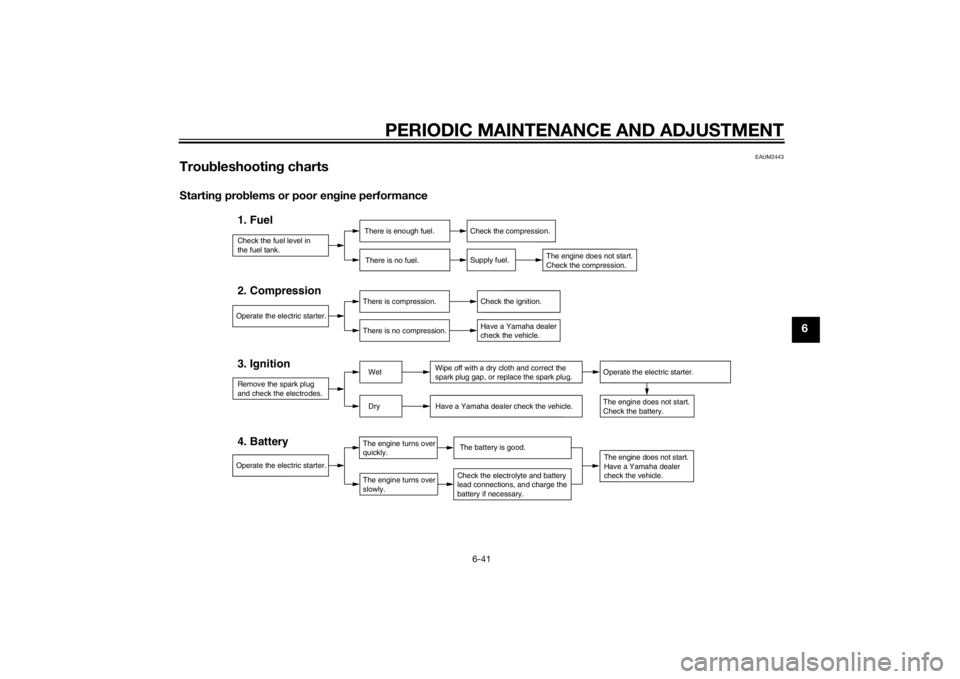
PERIODIC MAINTENANCE AND ADJUSTMENT
6-41
6
EAUM2443
Troubleshooting chartsStarting problems or poor engine performance
Check the fuel level in
the fuel tank.1. Fuel
There is enough fuel.
There is no fuel.
Check the compression.
Supply fuel.
Operate the electric starter.2. Compression
There is compression.
There is no compression.
Check the ignition.
Have a Yamaha dealer
check the vehicle.
Remove the spark plug
and check the electrodes.3. Ignition
Wet
Dry
Wipe off with a dry cloth and correct the
spark plug gap, or replace the spark plug.
Have a Yamaha dealer check the vehicle.The engine does not start.
Check the battery.
Operate the electric starter.
Operate the electric starter.4. Battery
The engine turns over
quickly.
The engine turns over
slowly.The battery is good.
Check the electrolyte and battery
lead connections, and charge the
battery if necessary.The engine does not start.
Have a Yamaha dealer
check the vehicle.
The engine does not start.
Check the compression.
U5D7E4E0.book Page 41 Thursday, July 10, 2014 3:01 PM
Page 84 of 96
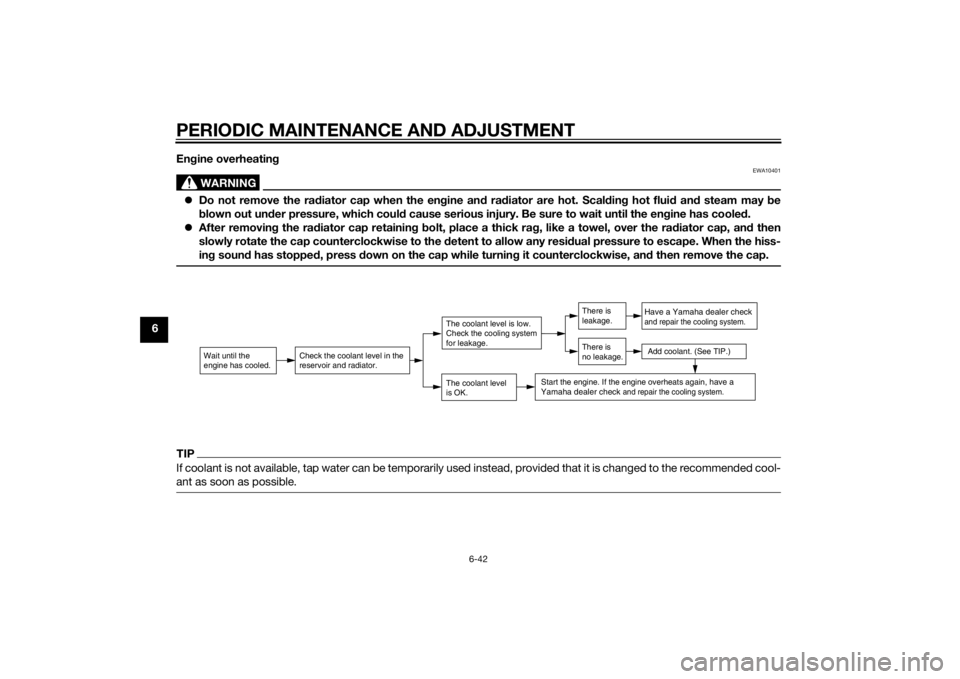
PERIODIC MAINTENANCE AND ADJUSTMENT
6-42
6Engine overheating
WARNING
EWA10401
Do not remove the radiator cap when the engine and radiator are hot. Scalding hot fluid and steam may be
blown out under pressure, which could cause serious injury. Be sure to wait until the engine has cooled.
After removing the radiator cap retaining bolt, place a thick rag, like a towel, over the radiator cap, and then
slowly rotate the cap counterclockwise to the detent to allow any residual pressure to escape. When the hiss-
ing sound has stopped, press down on the cap while turning it counterclockwise, and then remove the cap.TIPIf coolant is not available, tap water can be temporarily used instead, provided that it is changed to the recommended cool-
ant as soon as possible.
Wait until the
engine has cooled.
Check the coolant level in the
reservoir and radiator.
The coolant level
is OK.The coolant level is low.
Check the cooling system
for leakage.
Have a Yamaha dealer checkand repair the cooling system.Add coolant. (See TIP.)
Start the engine. If the engine overheats again,
have a
Yamaha dealer check
and repair the cooling system.
There is
leakage.
There is
no leakage.
U5D7E4E0.book Page 42 Thursday, July 10, 2014 3:01 PM
Page 88 of 96

MOTORCYCLE CARE AND STORAGE
7-4
72. Fill up the fuel tank and add fuel
stabilizer (if available) to prevent
the fuel tank from rusting and the
fuel from deteriorating.
3. Perform the following steps to
protect the cylinder, piston rings,
etc. from corrosion.
a. Remove the spark plug cap
and spark plug.
b. Pour a teaspoonful of engine
oil into the spark plug bore.
c. Install the spark plug cap onto
the spark plug, and then place
the spark plug on the cylinder
head so that the electrodes are
grounded. (This will limit spark-
ing during the next step.)
d. Turn the engine over several
times with the starter. (This will
coat the cylinder wall with oil.)
e. Remove the spark plug cap
from the spark plug, and then
install the spark plug and the
spark plug cap. WARNING! To
prevent damage or injury
from sparking, make sure to
ground the spark plug elec-
trodes while turning the en-
gine over.
[EWA10952]
4. Lubricate all control cables and
the pivoting points of all levers and
pedals as well as of the side-
stand/centerstand.
5. Check and, if necessary, correct
the tire air pressure, and then lift
the motorcycle so that both of its
wheels are off the ground. Alterna-
tively, turn the wheels a little every
month in order to prevent the tires
from becoming degraded in one
spot.
6. Cover the muffler outlet with a
plastic bag to prevent moisture
from entering it.
7. Remove the battery and fully
charge it. Store it in a cool, dry
place and charge it once a month.
Do not store the battery in an ex-
cessively cold or warm place [less
than 0 °C (30 °F) or more than 30
°C (90 °F)]. For more information
on storing the battery, see page
6-30.TIPMake any necessary repairs before
storing the motorcycle.
U5D7E4E0.book Page 4 Thursday, July 10, 2014 3:01 PM
Page 93 of 96

10-1
10
INDEX
AABS (for ABS models) .......................... 3-14
ABS warning light (for ABS models) ....... 3-3
Air filter element and check hose,
replacing and cleaning ....................... 6-14
Auxiliary light ........................................ 6-34BBattery .................................................. 6-30
Brake and clutch levers, checking and
lubricating........................................... 6-26
Brake fluid, changing............................ 6-23
Brake fluid level, checking.................... 6-22
Brake lever............................................ 3-13
Brake light switches ............................. 6-21
Brake pedal .......................................... 3-14
Brake pedal, checking and
lubricating........................................... 6-27
Brake pedal free play, adjusting ........... 6-20CCables, checking and lubricating ......... 6-26
Care ........................................................ 7-1
Catalytic converter ............................... 3-17
Clutch lever........................................... 3-13
Clutch lever free play, adjusting ........... 6-19
Coolant ................................................. 6-13
Cowlings, removing and installing.......... 6-8DDimmer switch...................................... 3-12
Drive chain, cleaning and lubricating ... 6-25
Drive chain slack .................................. 6-24EEngine break-in ...................................... 5-3
Engine idling speed, checking.............. 6-15
Engine oil and oil filter element............. 6-10Engine stop switch............................... 3-12
Engine trouble warning light .................. 3-3
FFront and rear brake pads, checking ... 6-21
Front brake lever free play, checking ... 6-20
Front fork, checking ............................. 6-28
Fuel ...................................................... 3-16
Fuel consumption, tips for reducing ...... 5-3
Fuel level warning light........................... 3-2
Fuel tank cap........................................ 3-15
Fuses, replacing ................................... 6-31HHandlebar switches ............................. 3-11
Headlight bulb, replacing ..................... 6-33
High beam indicator light ....................... 3-2
Horn switch .......................................... 3-12IIdentification numbers ........................... 9-1
Ignition circuit cut-off system .............. 3-19
Indicator lights and warning lights ......... 3-2
Info switch ............................................ 3-12LLicense plate light bulb, replacing ....... 6-35MMain switch/steering lock ...................... 3-1
Maintenance and lubrication, periodic... 6-4
Maintenance, emission control
system ................................................. 6-3
Matte color, caution ............................... 7-1
Model label............................................. 9-1
Multi-function meter unit ........................ 3-4NNeutral indicator light ............................. 3-2
PParking.................................................... 5-4
Part locations.......................................... 2-1
Pass switch........................................... 3-12RRider seat.............................................. 3-18SSafety information................................... 1-1
Shifting.................................................... 5-2
Shift pedal............................................. 3-13
Sidestand.............................................. 3-18
Sidestand, checking and lubricating .... 6-27
Spark plug, checking .............................. 6-9
Specifications ......................................... 8-1
Starting the engine ................................. 5-1
Start switch ........................................... 3-12
Steering, checking ................................ 6-29
Storage ................................................... 7-3
Supporting the motorcycle ................... 6-36
Swingarm pivots, lubricating ................ 6-28TTail/brake light ...................................... 6-34
Throttle grip and cable, checking and
lubricating ........................................... 6-26
Throttle grip free play, adjusting ........... 6-15
Tires ...................................................... 6-16
Tool kit .................................................... 6-2
Troubleshooting .................................... 6-40
Troubleshooting charts ......................... 6-41
Turn signal indicator light ....................... 3-2
Turn signal light bulb, replacing............ 6-35
Turn signal switch ................................. 3-12VValve clearance..................................... 6-16
U5D7E4E0.book Page 1 Thursday, July 10, 2014 3:01 PM